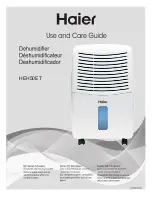
15
Product Overview
Nortec GS
2583701_C_EN_1812_Nortec-GS_OM
If a flame is not sensed by the flame sensor(s), the above sequence is repeated after 15 seconds. The
sequence is repeated upto a maximum of three times, after which the ignition control module(s) locks out
and the fault message "
" appears. If a flame is sensed by the flame sensor(s), the gas valve(s)
remains open and combustion continues. The gas valve(s) continues to maintain a constant air-to-gas
ratio independent of the blower speed or external conditions.
On the CS and NX models, the hot flue gases pass through the primary heat-exchanger then the second
-
ary heat-exchanger, where it is cooled further before it exits through the exhaust vent. The heat recov
-
ered by the secondary heat-exchanger is used to warm up the feed water. On the standard-efficiency
model, the hot flue gases pass through the primary heat-exchanger and exit through the exhaust vent.
Water Management
The Nortec GS humidifier is equipped with a fill box and a float chamber that monitors the water level
in the tank.
The combination fill box is connected to the tank and to the float chamber. The fill box is supplied with
water from the water supply, and from the secondary heat exchanger in CS and NX models. A vacuum
break valve is used to prevent siphoning in the drain connection.
In CS and NX models, a secondary heat-exchanger promotes higher efficiencies. This is achieved by
using the heat from the exhaust to pre-heat the cold fill water entering the fill box. Water from the fill box
then enters the bottom of the tank.
The float chamber is connected to the top and bottom of the tank to monitor water levels with reference
to the low operational pressure inside the tank. The float chamber and its control board consists of two
magnetic floats (one is a backup) that measure the water level. These levels correspond to 3 LEDs on
a display panel and are monitored by the control software.
Water Levels:
– L5 (yellow LED) – high water level
– L4 (green and yellow LED) – intermediate water level
– L3 (green LED) – middle water level
– L2 (green and red LED) – intermediate water level
– L1 (red LED) – low water level
On initial start-up, the dual fill valves fill the tank and the float chamber. A start-up test monitors the water
level as the tank and float chamber fills, and ensures proper functioning of the unit.
Note:
A fault message “Float Level” may appear at any time. This indicates an invalid combination of
readings from the control software (for example, if L5 and L1 LEDs activate at the same time).
1. The water level reaches the backup float, then the main float.
2. As water fills the float chamber and reaches the L1 level, the control software performs a test to
verify proper functioning of the dual fill valves and the drain pump.
a. Water enters the float chamber via the tank. The fill valves will allow water to fill the tank and
raise the water level in the float chamber to L5.
b. The drain pump energizes to lower the water level to just below L3.
Note:
The water levels should appear in ascending then descending order; L1, L2, L3, L4, L5, L4,
L3. A fault message “Fill Check Fault” appears if the water level does not rise to level L5. A fault
message “Drain Check” appears if the water level does not drop below the level L3.
3. When the test is complete, the dual fill valves activate and the water level should rise to level L3.
4. If a demand signal is present, the humidifier begins the combustion sequence.
5. The drain pump and dual fill valves maintain the water level between levels L2 and L5.
If Float Check is enabled during steam production, the control software will activate the drain sequence
every 24 hours (adjustable to any time of day) to verify proper functioning of the floats, dual fill valves,
and the drain pump.
















































